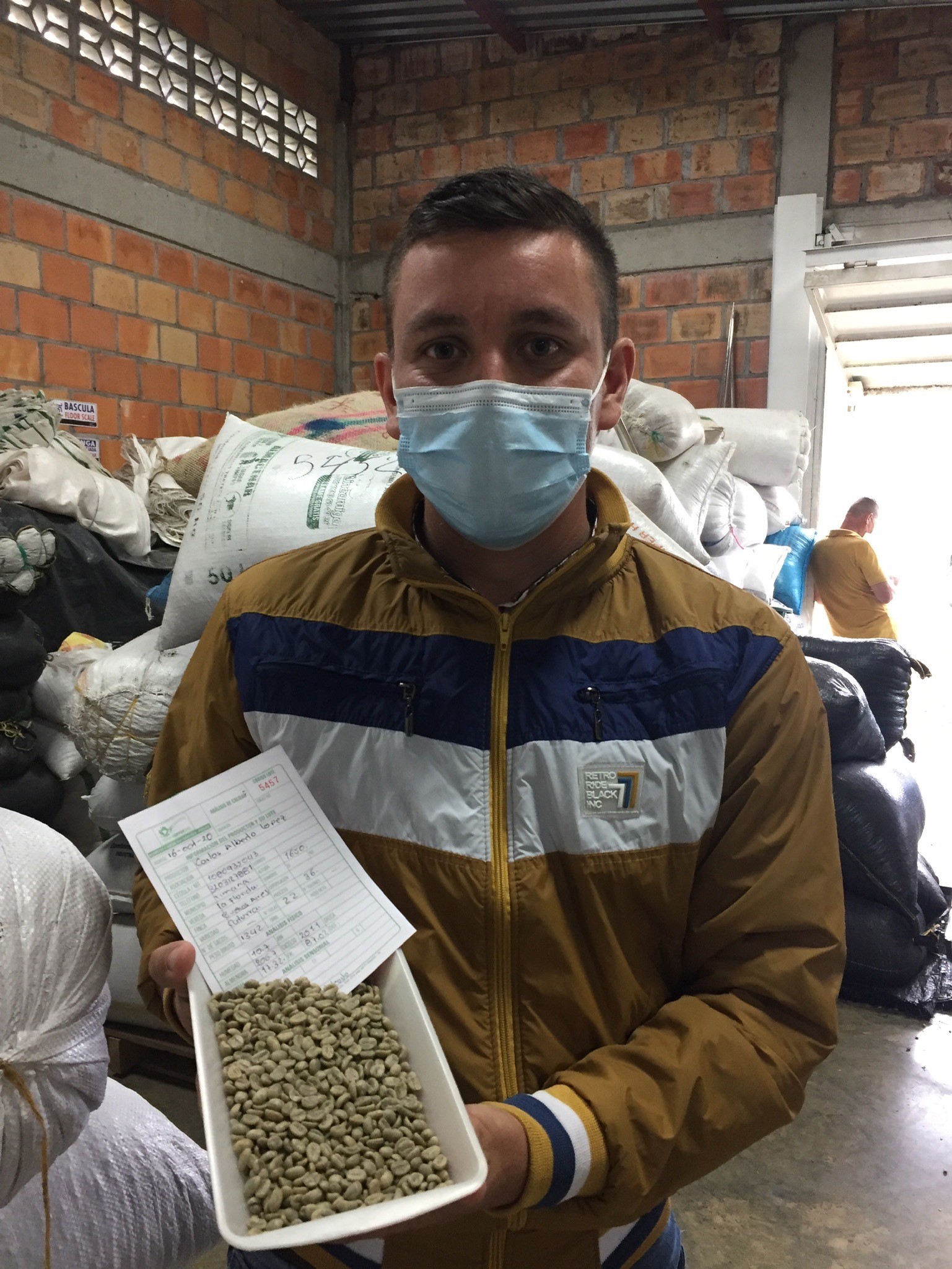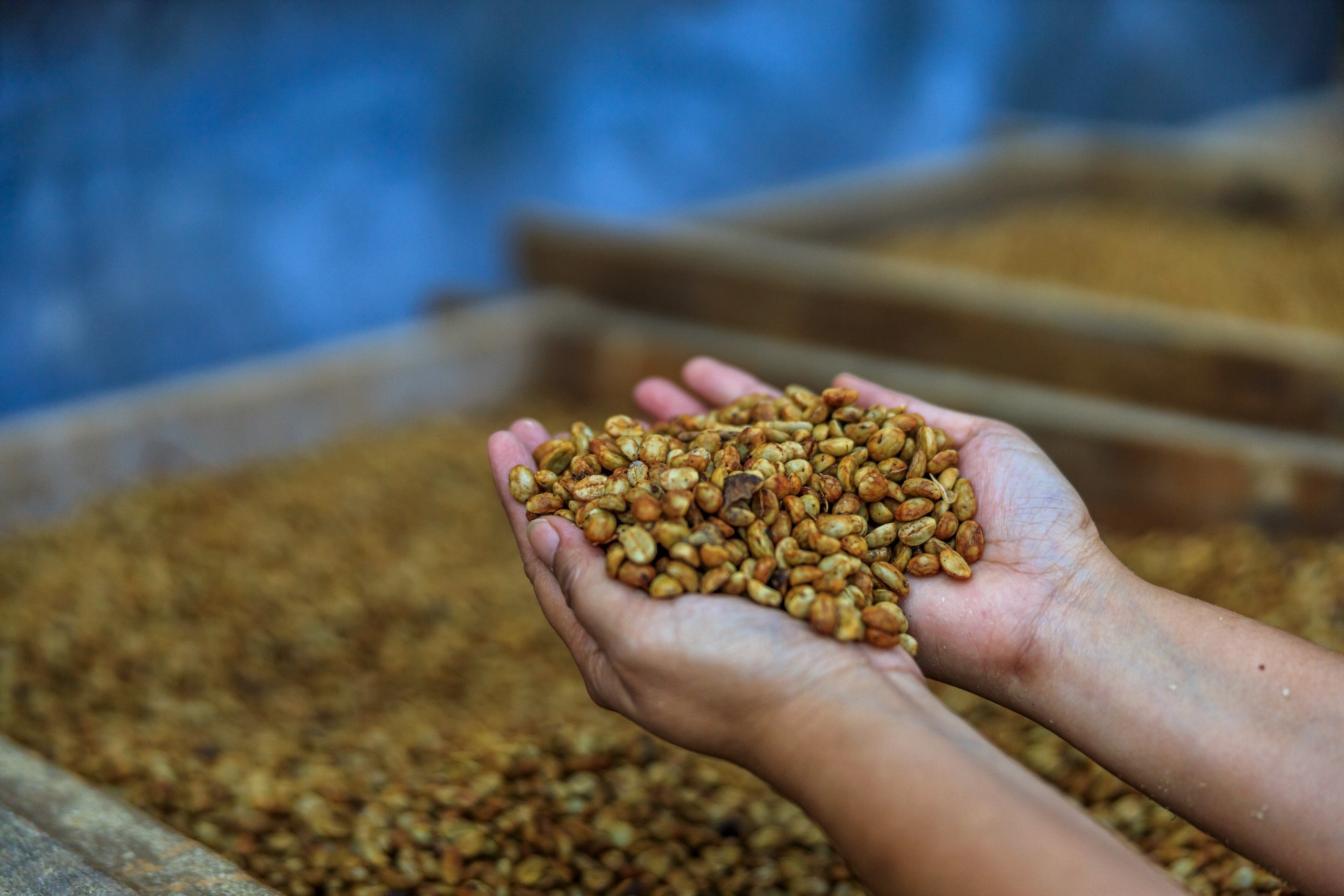Crown Jewel Colombia Huila Double Macerated Honey Pacamara
Boxes 0
Warehouses Oakland
Out of stock
overview
Overview
This is an experimental double-macerated honey coffee from Huila, Colombia, produced by a small group of farmers organized around Terra Coffee.
The flavor profile is clean and complex, with notes of tropical fruit like papaya and guava, a zesty malic and citric acidity, hints of floral tones and spiced cider, and an exuberant sweetness.
Our roasters found the coffee well mannered despite unusual green metrics, and urge a little caution against late roast uptick in heat delta.
When brewed, the coffee was complex and showed off a wide range of flavors at various brew styles. We are serving the coffee as a limited pour-over option at The Crown.
taste
Taste Analysis by Chris Kornman
We’re head over heels for this incredible, complex, delicious experimental coffee from Huila. I love Southern Colombia arrivals in the autumn, and this is really one to celebrate. You don’t have to be a fan of Pacamaras or Honey Processing methods to get it, either (though it doesn’t hurt). The coffee stands on its own merits as a meticulously picked and processed microlot showing off a whole new side of Huila you didn’t even know you were missing. One sip and you’ll wonder where it’s been your whole life.
The bright, zesty acidity I think is what really grabs you right off the bat, but it’s not the thing that holds onto your attention. That’d be its complexity, and it starts out just subtle enough to evoke symphonic orchestration rather than cacophonous chaos. Papaya, guava, mango, and pineapple are some of the most unique, idiosyncratic notes we first notice, but there’s so much more. Floral notes reminiscent of lilac round a corner into warm seasonal spice, like a Thai iced tea or fresh hot spiced cider. A lingering, sweet finish of nearly equal parts caramelized and raw sugars completes the experience. It’s on my short list of favorite coffees of the year.
source
Source Analysis by Mayra Orellana-Powell
Ever stop to think about all the variables that factor into creating a distinct, complex, clean and consistent community blend? Here is one you will want to dissect. With one-part terroir (from the coveted department of Huila), one part variety (Pacamara), one part processing innovation (double fermented), and one part farmer collaboration (the backbone of Colombian production).
This community blend with a vibrant regional profile and unique processing character was produced by 8 farmers committed to following a specific processing protocol (double fermented) to draw-out a pronounced fruit forward profile. Using their own micro-mill, each producer fermented their carefully harvested cherries for 40 hours before depulping and then fermenting again in tanks for another 12 hours. After this distinct process of fermenting, the coffee with mucilage still attached was moved to raised beds to gently dry for 25 days.
This is the hallmark influence of Terra Coffee SAS, which has been stepping in with innovative post-harvest strategies and cupping expertise throughout Huila and Nariño. Then Mastercol adds crucial logistical support for things like warehousing and milling so this lot can reach the international market.
green
Green Analysis by Chris Kornman
Just about everything about this green coffee is really unique. Pacamara is not the world’s most common cultivar, and while grown outside of El Salvador (where it was developed as a Pacas / Maragogipe hybrid) it’s pretty rare. Beyond this, the coffee is a double macerated honey, which is also extraordinary. Honeys rarely undergo formal fermentation, and the two-stage process here prior to drying imparts unique appearance and flavor. Notably, the coffee is covered in a dark, orangey silverskin.
As Pacamaras go, this is a slightly smaller, slightly denser iteration than average, though still registering relatively large in screen size (about 80% 17+, albeit spread somewhat widely and evenly from 16-19). The coffee clocked in at above average moisture and water activity as well. All these factors make for a coffee that could present some interesting idiosyncrasies in the roaster. Mostly, you’ll want to keep an eye on even color development and generally not push too hard with the gas.
Loring S15
Loring S15 Falcon Analysis by Chris Kornman
Switching things up a little this week, I wanted to work on developing a small batch profile on our 15kg capacity Loring S15 Falcon. The apparent recommended minimum roast size on this machine is around 3kg, or 6.6lbs, but in keeping with the spirit of consistency and repeatability, I wanted to work on a 5.5lb (2.5kg) batch, which allows for four roasts out of a 10kg Crown Jewel box.
Despite manufacturer recommended charge temperature well below 300F, I began working with a higher charge temperature on this slightly denser than average Colombian coffee, around 360F. Instead of hitting the gas as soon as possible, I waited until the coffee reached its turning point and ramped up to 50% power for the subsequent 3 minutes of roasting. Color change came quickly and I did my best to ride a balanced approach during Maillard reactions, taking the gas down to 30% and allowing the coffee to stretch during this phase. As soon as first crack was detectable, I dropped the gas to the minimum 20% setting and hoped to coast. The rate of rise remained relatively low, and color developed on pace for a relatively short, light drip style roast.
The longer percentage of time in Maillard allowed color to develop somewhat evenly, and the external and internal Colortrack readings just edged a little over 5 points difference at 60.88 and 54.91, respectively. Overall, the coffee behaved far more predictably than expected, particularly after color change began to be apparent.
For a first roast of this coffee, I was exceedingly pleased with the cupping notes on the table and found the coffee remarkably complex and enjoyable. It might be a good idea for most roasters to keep an eye on rate of rise as first crack begins, and attempt to avoid any late-stage acceleration, probably especially risky if early stages of roasting occur on the quick/hot side.
Bullet R1 IBTS
Bullet R1 IBTS Analysis by Evan Gilman
This was my very first roast on the Bullet! As I get used to working on this machine, you’ll see my parameters and suggested approach change. Consider the analysis below as a good starting point, but not the end all be all of roasting on the Bullet. More to come!
For this roast, I started with 250g of coffee, 383F charge temperature at the IBTS, P4 heat application and F5 fan. Due to the smaller size of this roast, I used D6 drum speed.
Roasting on a new machine is always an adventure! What better way to start and adventure than with an adventurously different cultivar and process? If I’m going to be out of my element, let me be thoroughly out of my element for maximum enjoyment.
While the setup was anything but routine, this coffee proved to be incredibly easygoing in the roaster. The Bullet is a little bit more analogous to the Loring than the Quest M3s was, so I followed along in Chris’ footsteps a bit. This coffee has a good spread of screen sizes, meaning that comparatively more heat will be required to bring this coffee through the roast cycle. The higher moisture content and higher density of this coffee also work against the thermal ‘push’ we give it in the roaster, in different ways. My goal here was to give enough energy to complete this roast, but not allow it to race towards the end, something that high density and higher moisture content coffees are prone to do. That meant I started with a high charge temperature, allowed the coffee to plunge to as low of a turning point as possible, then hit it with considerable heat until about halfway through Maillard.
As you can see in the graph below, I began with what I now understand to be a very high fan speed – F5. I have found that in its current state, the Bullet will really lose a lot of heat when using fan speeds of F4 and above. I also started with a medium-low heat application of P4, ramping up to P7 and down to F1 at turning point like I would with the Quest M3s. This worked out fairly well, but the high fan speed at the outset disallowed the rate of rise I would like to see early in a roast. I kept heat fairly consistent through this roast, lowering to P6 at around 5:00 / 345F.
Though this roast still turned out very quaffable, my mistake was in increasing fan speed to F5 thinking that my momentum would continue to carry me through first crack and beyond. I was met with a drastic drop in delta/rate of rise, and my roast spent a lot of time in the 360F – 380F range. If you’re working with this machine, do be careful with the very effective fan speed, especially with lower volumes of coffee in the drum!
All that being said, this was in my estimation a very successful first roast. I spent 45% of time in green/drying stage, 39% in Maillard, and 14% in post-crack development.
In the cup, this coffee flaunted its easygoing nature in the face of my concern. Turns out that the Bullet didn’t shoot this coffee through with any of my consternation, and the brew was crisp and clean. Honey, mango, fresh berries, and lime coated my palate. As it cooled, tart and winey grape flavors, and a distinct floral flavor manifested. The only thing holding this roast back was a somewhat sharp grapefuity quinic acid flavor on the finish – something I attribute to a bit of underdevelopment.
brew
Brew Analysis by Nate Lumpkin
This week we decided to brew this coffee up on the Saint Anthony C70 and Bee House dripper in preparation for releasing it onto our pour-over bar. For both of these brews we used our standard recipe of 18g coffee and 300g brew water, though we varied grind and bloom slightly. Regardless of method, we found a cooperative but complex coffee that showed a range of surprising tasting notes, and I can’t wait to be offering it for service!
On C70, we started with a grind of 8.5 on the EK. This cup brewed through in 3:18, and showed a TDS on the low end, at 1.26, with an extraction of 18.46%. In the cup we tasted a deliciously juicy range of notes, including pineapple, lime zest, strawberry, banana, orange bitters, Thai iced tea, black tea, and almond butter, with a slightly dry finish. It turned even juicier as it cooled!
On Bee House, we started with a grind of 8.5 but fined it up to an 8, to try to punch up the extraction even more. This cup brewed through at 2:43, and as expected showed a higher TDS of 1.38 and an extraction of 20.24%. The first thing we noticed was a strong aroma of tropical fruits that was just amazingly sweet. In the cup we tasted a range of tropical fruit notes like papaya and guava, as well as grape, tangerine, blood orange, sour cherry, lemon-lime, and a hint of sweet wood like cedar, we well as a pleasant dry finish, and an intense sweetness reminiscent of raw sugar. We decided to feature this coffee on our pour-over bar with the Bee House, which you can taste this weekend!




